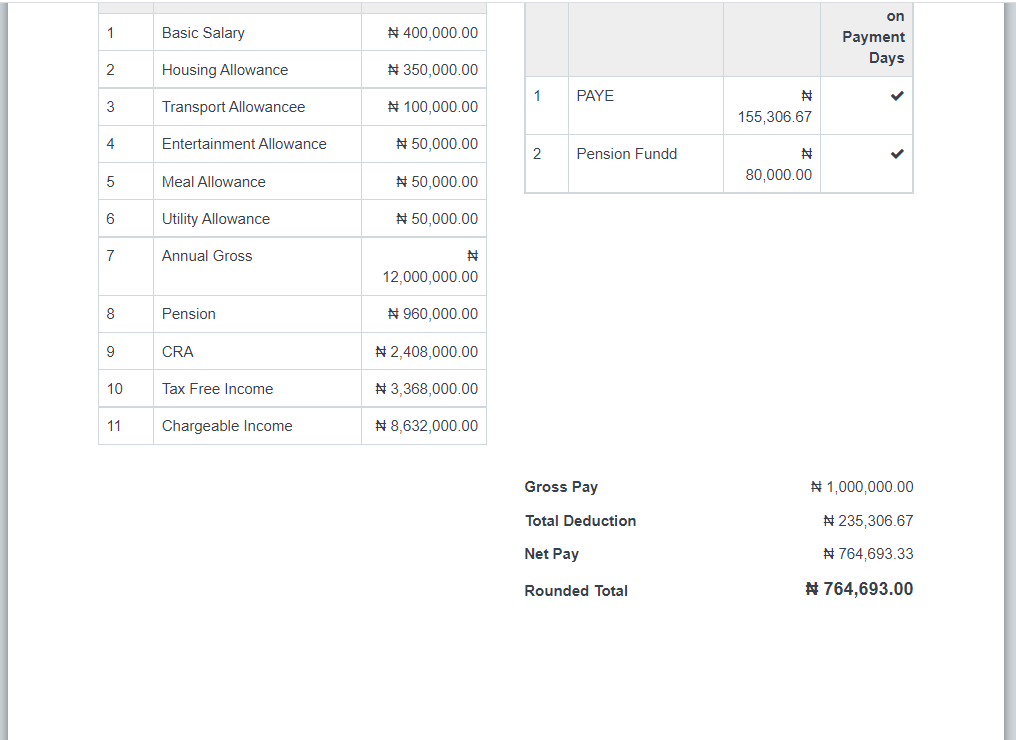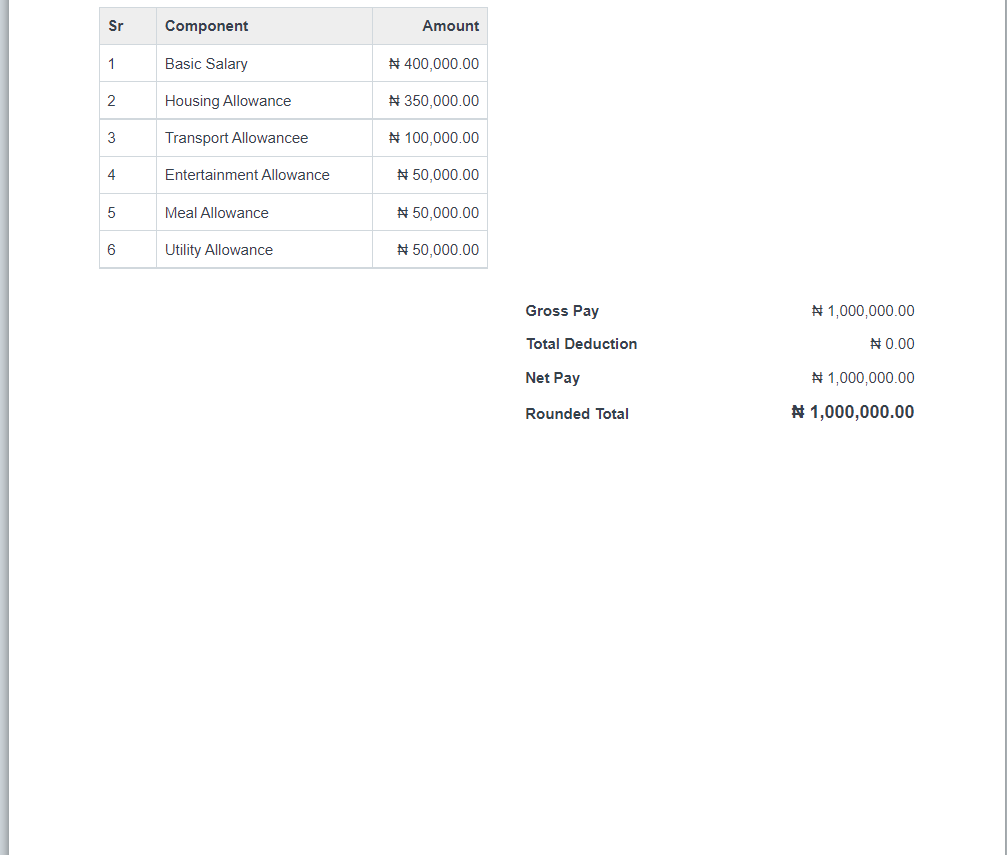Okay so I’m just going to dump mine here so you can compare with yours to see what could be different.
i really must appreciate your effort and time in helping me out, trust me i sincerly do but as at this hour, i have compared both with mine yet i dont know why my results are different ![]() . Does it have anything to do with the unticked check box on each salary component or version or anything ?
. Does it have anything to do with the unticked check box on each salary component or version or anything ?
Hi @Chibuzor_Derrick, If you are still having issues replicating @flexy2ky suggestions then I suggest you take a step back and ensure the salary components are of the correct types, Generally,
-
Employer Contribution (10% of Basic, Housing, Transport) should be tagged as “do not add to total” with its values not contributing to the total deductions.
-
Consolidated Relief Allowance, Taxable Income, Additional Tax Relief, All Tax Payable Slabs should be Statistical components, so they can be calculated alone.
-
Employee Contribution (8% of Basic, Housing, Transport), PAYE (Income Tax) should be normal deductions with their values contributing to the total deductions.
One way to easily identify the source of the issue would be to change them all to generic components so that they can be seen on the salary slip so as to see where the calculations break.
Earning : all statistical component are unticked to “dont add on total” and the rest are ticked “depend on payment days”
Deduction: all statistical component where ticked and the rest are “depend on payment days”
i can categorically say that the calculation is correct using the snip_shots from @flexy2ky as shown above
by the time i ticked statistical component for (annual gross,pension,cra,taxfree income, chargable income) in the earning. i get this
Move them to deduction section
Hi, @Ebuka_Joseph_Akeru do you mean that the highlighted checkbox in the image below should be ticked (The checkbox where it says “Do not include in total”) for the Basic, Housing, Transport e.t.c?
No, I mean you should check it for only Employer Pension which is 10% of Basic, Housing, and Transport. Those components should be set as normal components.
Ok, thanks for the explanation.
ok good
Nigerian PAYE 2021 is a little different from the previous years.
If you use the formula in salary components, it’s a good idea but becomes difficult to understand in the long run. If in the nearest future, the formula is changed again you begin to scramble because tracking the spot to change is cryptic.
The PAYE TAX can be easily achieved with a plugin that validates instantly both on salary slip form, or in the background.
There is also an option of API based PAYE computation that interface with your erpnext.
Both solutions available.
@Huawei_Hackace Thanks for bringing this up. However from my little investigation so far not much has changed in the way tax computation for salary earners is achieved. The tax derivation formula is more or less the same, save for an additional element in determining your non-taxable income. Essentially the extra element is 1% or N200,000+20% of gross income (whichever is higher) is added to the tax-exempt income. Everything else is same. I have not attempted to add this tax-exempt to my existing structure but will do so at a later date.
As for tracking changes, someone will always need to adapt changes to any software so be it your suggested plugin or using the existing condition/formula in ERPNext; someone still has to do the dirty work. ERPNext, for all its quirks, still offer ways to achieve these things and just like I figured out a way to use the current salary structure to achieve the previous tax calculation, I will find a way to incorporate this new tax element.
Hello all,
After configuring the salary structure, and salary component, it came out like this.
The computation for the different salary components is correct according to their calculation. But when you look at the gross pay, net pay and rounded total, they don’t add up. Please I am a bit confused as to how to correct or resolve this miscalculation. I will be grateful if anyone can assist in resolving this error, I will be very grateful.
There are several errors in what you have done.
- Your computation formula is wrong on different levels. You captured your earnings as annual figures and some as monthly figures. This will give you a wrong computation for the month.
- Also, ignore the rounded total. Disable it in payroll settings and hide the field in the doctype.
- Some of the elements you reflected on the payslip are meant to be statistical components only and should not affect your totals.
Overall, you need to review what you have done against examples posted above and make corrections.
Thanks for your response @flexy2ky. Your response gave me an insight into where the errors are, and how to correct them. However, here is the outcome after following your corrections.
The circled components are the components that are computing the wrong figures. I would want a situation whereby the “Pay As You Earn” component computes the right figures, but can’t seem to achieve this.
Here are screenshots of my configuration using the examples given in this thread. Thanks for the help.
@Nwokoro_Nkemakolam here are issues I noticed:
- Tax Payable 1 - 7 are statistical components and are not to be included in totals so check those boxes
- Employer Pension remittance does not factor into tax calculation so I don’t know why it’s part of your statistical components. If your intention is to pass the necessary ledger entries for employer contributions then you need to create it as a component both in earnings (your employer pension contributions expense ledger will be credited) and deductions (your pensions liability ledger will be debited) while checking the "Do not include in total field.
- Only your earning components need to Depend on payment days. If your deductions also depends on payment days then your calculation will return false results as your deductions formula already depend on the values returned by the earnings to determine what values it calculates deductions on.
In summary, from what I can see based on the screenshots you sent above, the issues listed above are the key sources of the error you are facing. Resolve these let’s see if you can get the right data.
Hope this helps.
Br.
Hello @flexy2ky thanks for your contribution so far.
I’m trying to manage deductions like insurance premiums on the platform but can’t seem to automate it, the only fix I have for now is manually adding the deductions like life assurance to the individual salary structures and entering the amount.
Any ideas on a more practical approach?
Kind Regards
Good day all,
I have ventured into customizing Payroll Calculation for Nigeria, and I have not been able to get it right even with all the recommendations and corrections that have so far been shared here on the forum. So I’ll go straight to the point by posting my configurations here.
Please if there’s anyone going through this, can anyone assist by pointing out to me why I can’t get the PAYE right? @flexy2ky @Ebuka_Joseph_Akeru if you guys are available, can you help with this, please?
Thank you very much
Hello @skizz ,
I am assuming you are getting values, but they do not align with your reference document.
Replicate every component from the reference document using the conditions and formula fields. I would advise you to make every component reflect on the salary slip so it becomes easier to track.
In my experience, It is important to capture the Consolidated Relief Allowance (CRA), Taxable Income, and the 6 PAYE deduction bands as individual components. similar to what you have done.
Hello @Ebuka_joseph_Akeru, thank you for your response.
I have that is what I have done, replicated every component from the reference document using the conditions and formula fields.

































